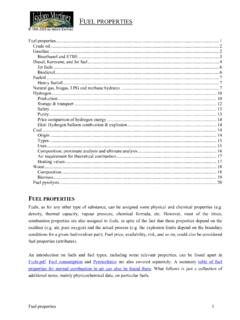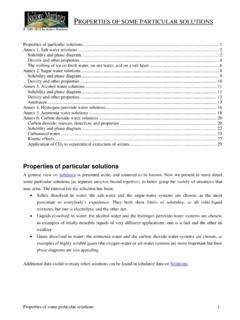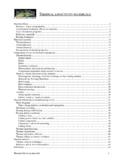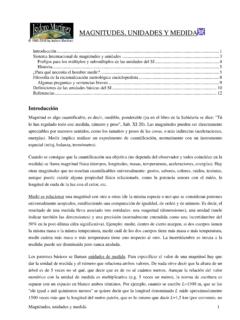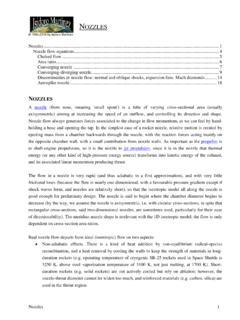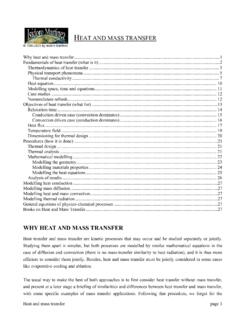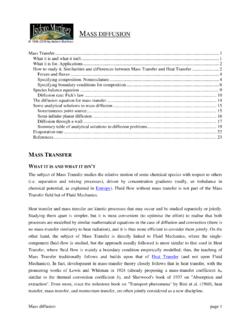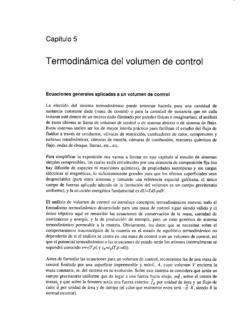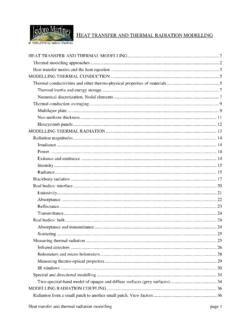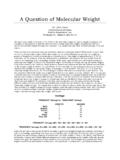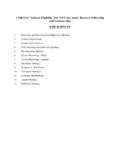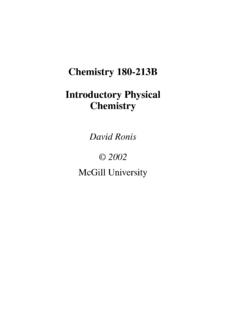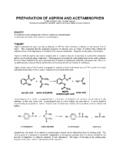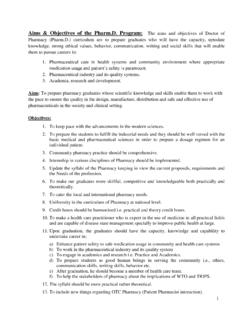Transcription of THERMODYNAMICS OF SOLUTIONS - UPM
1 THERMODYNAMICS of SOLUTIONS 1 THERMODYNAMICS OF SOLUTIONS SOLUTIONS quantification .. 1 Mixtures and SOLUTIONS .. 1 Concentration specification .. 4 Moles-of-solute variables .. 5 Mass-of-solute variables .. 6 Volume-of-solute variables .. 7 Concentration measurement .. 7 Solution preparation from pure solutes and concentrated SOLUTIONS . Dilution .. 8 Dissolving rate .. 9 Electrolytic SOLUTIONS .. 9 Solution properties .. 10 Phase diagram .. 10 THERMODYNAMICS of solubility .. 11 Qualitative solubility. Solubility rules .. 12 Solute equilibrium and its temperature variation .. 12 Solubility equilibrium for gas solutes .. 13 Solubility equilibrium for solid solutes .. 17 Partition of a solute between two immiscible solvents .. 20 Supersaturation. Undercooling and overheating. Hydrates and clathrates .. 20 Density .. 21 Heat of solution .. 23 Freezing mixtures .. 24 Colligative properties .. 25 Vapour-pressure depression .. 25 Freezing-point depression .. 25 Boiling-point increase.
2 26 Osmotic pressure .. 26 Properties of particular SOLUTIONS .. 27 Thermochemical data of solutes .. 27 Solubility data for aqueous SOLUTIONS .. 27 Density data for SOLUTIONS .. 27 Heat of solution data .. 27 Cryoscopic and ebullioscopic data .. 27 SOLUTIONS quantification Mixtures and SOLUTIONS A mixture is any multi-component system, one with several chemical species. The THERMODYNAMICS of mixtures in general (gaseous, liquid or solid) has been considered under the heading Mixtures, mainly devoted to ideal mixtures. The term 'solution' is mostly used for the special case of a mixture between very dissimilar components, when a small amount of substance, called solute (solid, liquid or gas), dissolves to a certain limit in a liquid or solid substance (pure, or a mixture itself) called the solvent. In many SOLUTIONS of interest, the sum of the mole fractions of the solutes is small compared to unity, and the solution is called a dilute solution.
3 We assume true SOLUTIONS , homogeneous SOLUTIONS , and do not consider colloids and THERMODYNAMICS of SOLUTIONS 2 suspensions, treated under the heading Mixture settling. Reacting mixtures are covered in Chemical reactions, aside. Most SOLUTIONS depart from the ideal-mixture-model developed in Mixtures, but it is important to recall the basic result from the multiphase equilibrium of ideal mixtures, Raoult's law for ideal vapour-liquid-equilibrium (VLE): *,,()i gasii liqxpTxp= (for ideal mixtures) (1) , for any component i, its molar fraction in the vapour phase, xi,gas, is to its molar fraction in the liquid phase, xi,liq, as its pure-component vapour-pressure at that temperature, *()ipT, is to the actual pressure, p. If a solution behaves as an ideal mixture, Raoult's law for each component in a binary mixture of solute 's' in solvent 'dis', in terms of solute mole fractions would read: **,,,,1()()and1s gass gassdiss liqs liqxxpTp Txpx p == (2) which can be approximately solved in the following limits like that: for **disspp>> ( salts in water) *,*,()1()s gasss liqdisxpTxpT=<< and ()*,1diss liqppx= (3) for **disspp<< ( gases in water) *,*,()1()s liqdiss gassxpTxpT=<< and ()*,1ss liqpp x= (4) with the following interpretation: when a non-volatile solute dissolves in a liquid, (3), it lowers the solvent VLE-pressure, and its fraction on the vapour phase is proportional to its vapour pressure when pure (negligible).
4 When a very-volatile solute dissolves in a liquid (4), it lowers the solute VLE-pressure, and its fraction on the liquid phase is proportional to the vapour pressure of the pure solvent (small). SOLUTIONS are everywhere: seawater (but also tap water), coffee, soda, wine, vinegar, gasoline, antifreeze, body fluids ( human plasma is roughly an 8%wt proteins plus 1% salts in water, milk serum is roughly a 5%wt lactose plus 3% proteins in water, urine is roughly a urea plus 2%wt salts in water), etc. Milk may appear to be a homogeneous mixture to the unaided eye, but the tiny oil and protein droplets in the system make milk to appear white (milk is a colloid). Sea water contains many ions in addition to sodium and chloride ions; when gradually evaporated, the first salt to precipitate is CaCO3 (present to the extent of g/L), followed by CaSO4 H2O ( g/L), then NaCl ( g/L), MgSO4 ( g/L), MgCl2 ( g/L), NaBr ( g/L), and KCl ( g/L).
5 Solvents should be inert (not react with solutes), volatile (low boiling point, to ease distillation), and recyclable. They are usually grouped as: THERMODYNAMICS of SOLUTIONS 3 Polar solvents (water, methanol, ammonia). Polar solvents are hydrophilic, usually H-bond donors (like water itself, the most important solvent by far), or through hydroxyl groups as in ethanol (CH3-CH2OH), or through carboxylic groups like in acetic acid (CH3-COOH). Polarity is measured by the dielectric constant. Some polar solvents are organic, notably acetone (they are not H-bond donors). Non-polar solvents (benzene, toluene, ether, hexane, carbon tetrachloride, trichloromethane (chloroform), methylene chloride, gasoline, mineral oil). Most organic solvents, greatly used in the chemical and biochemical industries (food and pharmacy), are harmful to health and the environment, and are being replaced by supercritical fluids.
6 'Dry cleaning' is not dry at all; it is said dry because the liquid is not soaking water by a volatile solvent (usually 1,1,2,2-tetrachloroethene). Carbon dioxide is a non-polar fluid, but has poor solvent properties outside supercritical conditions. Supercritical fluids (carbon dioxide, ethane, trifluoromethane (fluoroform), sulfur hexafluoride, di-nitrogen oxide (nitrous oxide), carbon disulphide). Supercritical fluids show a dissolving power quickly increasing with pressure (up to a limit). Pure supercritical carbon dioxide is a relatively non-polar solvent, but has some limited affinity with polar molecules due to its large molecular quadri-pole, although modifiers ( methanol, fluorinated hydrocarbons) can be added to improve the solubility of polar molecules. Supercritical water becomes totally miscible with many organic compounds like heptane and benzene. An advantage of supercritical solvents is that they yield the dry solute by simple evaporation of the solvent.
7 The range for supercritical applications is p/pCR= and T/TCR= The main solvent is water, and thus most SOLUTIONS are aqueous SOLUTIONS . Most solutes are solid powders ( salt-water SOLUTIONS ). Water scarcely dissolves gases and organic liquids, and liquid-liquid SOLUTIONS may be considered plain mixtures; that is why the basic understanding of to dissolve is to untie a solid to become part of a liquid. It is the solvent that pulls the solute into solution, and its internal motion (diffusion and convection) what spreads the solute around. Some details on mixing can be found aside in Mass transfer and in Chemical kinetics. Usually, solutes do not dissolve on the solvent vapour ( they are usually non-volatile), neither on the solvent solid phase (they do not fit into the crystalline lattice). Both mentioned-processes can be used to get rid of solutes ( salt water becomes fresh water when vaporised or solidified), at least when done carefully, but, in practice, solutes can be entrained by solvent-vapours (mainly as an aerosol of particles) and can be trapped within the solid solvent (at the seashore, one may feel salty lips just from the marine breeze, and some ice may taste salty too).
8 All SOLUTIONS have some stratification of composition at equilibrium, as studied in Mixture settling. Besides, solution tend to change the composition with time in open systems, in SOLUTIONS open to the atmosphere or when the solution is blooded someway, since the escape will not have the same average composition; the composition inside a liquefied-petroleum-gas bottle changes during use, becoming richer in the heavier components, as well as within a liquefied-natural-gas tanker, due to the boil-off. The relative amount of solute in a solution (its concentration) may be measured by different concentration variables related amongst them (but not always in a trivial manner); since all SOLUTIONS depart from ideal THERMODYNAMICS of SOLUTIONS 4 (Raoult s law) mixtures, the use of molar quantities for the solvent is rare (molar quantities were an advantage for modelling ideal mixtures because, in that case, the behaviour is just proportional to the molar composition, independently of the actual substances involved).
9 Concentration specification One of the main difficulties in the study of SOLUTIONS is the wide variety of variables and units used to specify concentration (in the case of ideal mixtures, only molar fractions, and sometimes mass fractions, were common). Generically speaking, concentrations in a mixture express the quantitative composition (although, under the SI standard, composition must refer to the unit volume of the system, mol/m3, kg/m3). The subject gets obscure also by the lack of a clear nomenclature, to distinguish with a letter from 'solution' (we will use subscript m, from mixture), 'solute' (we will use subscript s, from solute) and 'solvent' (we will use subscript dis, from dissolve); the standard labelling of '1' for solute and '2' for solvent, may be unclear when one wants to distinguish between solvent and solution. To give an idea of the variety of variables used, consider the following values for oxygen-solubility in water (all of them valid under certain circumstances): 39 mg/kg, kg/m3, mol/m3, 22 ppm, ppm, mol/m3, mg/L, mL/L, 55 mL/L, to name a few.
10 And, fortunately, oxygen solubility is so small that the value is the same by amount of solution than by amount of solvent. The explanation of the above figures is that 78 mg/kg is equal to 78 mg/L for aqueous SOLUTIONS where 1 L has 1 kg; it is also equal to 78/32= mol/m3; and it is also equal to 22 parts per million molar, but these values refer to concentration of dissolved oxygen in equilibrium with pure oxygen at 25 C and 100 kPa (a common physical standard state). However, when the equilibrium is not with pure oxygen but with air at 25 C and 100 kPa, previous values have to be multiplied by xO2,air= , giving 22 ppm, 39 mg/L, equal to mg/kg for water, and equal to mol/m3. Finally, the volumetric fractions refer to the volume at 0 C and 100 kPa that the full out-gassing of dissolved oxygen in one litre of solution at a given temperature, would occupy: 55 mL/L means that the oxygen dissolved in 1 L of solution would occupy 55 mL as a pure gas at 0 C and 100 kPa, a value that is correct for a solution at 25 C saturated against pure oxygen at 0 C and 100 kPa; if it were against air instead of pure oxygen, the value would be 55 mL/L for air at 0 C, and, as solubility of gases decreases with temperature and nearly halve from 0 C to 25 C, in equilibrium with air at 25 C and 100 kPa the value is mL/L for air at 25 C).
